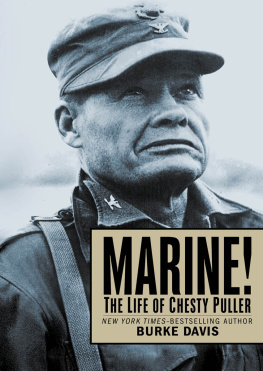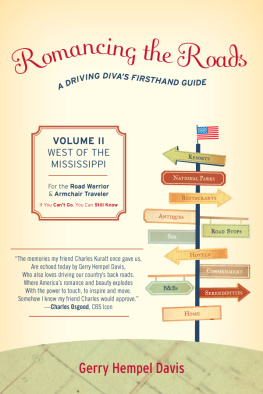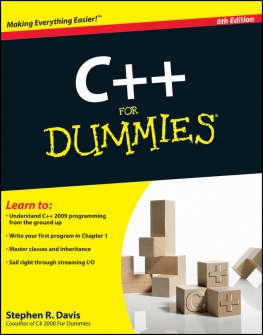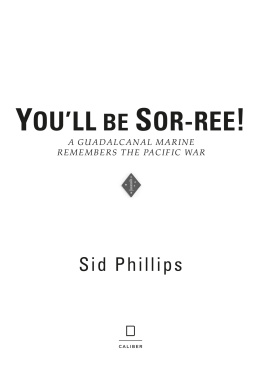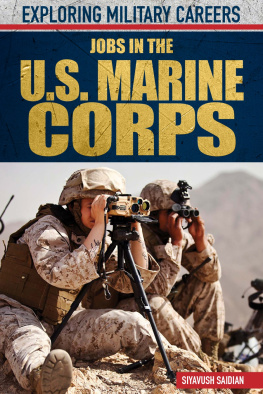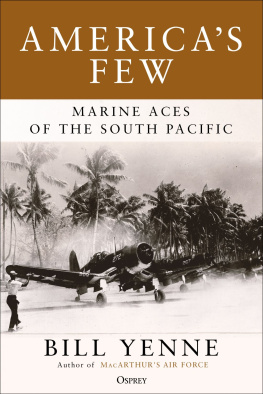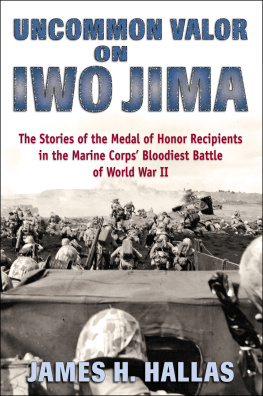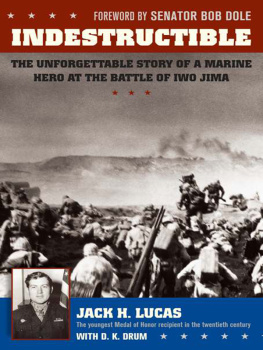Marine!
The Life of Chesty Puller
Burke Davis

CONTENTS
To the thousands of Marines who served with General Puller in four wars
ACKNOWLEDGMENTS
The author acknowledges with gratitude the following, who did so much to make this book possible:
Henry Adams, San Diego, Calif.; Thomas H. Barry, Evanston, Ill.; Miss Lucille Bland, West Point, Va.; John A. Blazer, Madison, Tenn.; Mr. & Mrs. Jan Bodey, Paramount, Calif.; Mrs. Rose Altizer Bray, West Point, Va.; Ralph M. Briggs, Jr., Griffin, Ga.; W. R. Broaddus, Martinsville, Va.; Maj. Charles H. Brush, Jr., USMC, Quantico, Va.; Leon Brusiloff, Chevy Chase, Md.; Adm. Arleigh Burke, USN, Ret.; Maj. George Chambers, USMC, Camp Lejeune, N.C.; Col. Parker R. Colmer, Industrial College of the Armed Forces, Washington, D.C.; Col. David F. Condon, Military Court of Appeals, Washington, D.C.; Zach D. Cox, Mount Olive, N.C.; Sgt. Robert Cornely, USMC, Quantico, Va.; Lt. Gen. E. A. Craig, USMC, Ret., El Cajon, Calif.; PFC Paul Curtis, USMC, Camp Lejeune, N.C.
Maj. Lew Devine, USMC, Quantico, Va.; Robert Dutro, Yorktown, Va.; William Evans, Richmond, Va.; Maj. Don Ezell, USMC, Quantico, Va.; David Feild, Georgetown, S.C.; John deSparre, King William Courthouse, Va.; William Ferrigno, Winter Park, Fla.; Maj. Joseph Fisher, Sgt. Carl Fulgenzi, and Col. Regan Fuller, all of USMC, Washington, D.C.; Ambassador James Gavin, Paris, France.
Peter Hackes, National Broadcasting Company, Washington, D.C.; James M. Hayes, Jr., Winston-Salem, N.C.; Henry Heming, New York City; William B. Hopkins, Roanoke, Va.; Peter Hoyt, Fort Worth, Texas; Col. C. W. Kelly, Jr., USMC, Camp Lejeune, N.C.; Sgt. Mike Kolomy, USMC, Philadelphia, Pa.; Col. Edmund H. Lang, U.S. Army Corps of Engineers, Vicksburg, Miss.; Col. William Lee, USMC, Ret., Quantico, Va.; E. E. Linsert, Alexandria, Va.; Capt. John B. Lippard, USMC, Camp Lejeune, N.C.; W/O William E. Lisenby, USMC, Jacksonville, Fla.; Maj. Gen. Homer Litzenberg, USMC, Ret., Washington, D.C.; John Loomis, Arroyo Grande, Calif.; Maj. Gen. Frank E. Lowe, USA, Ret., Harrison, Me.; O. T. Lussier, Pasadena, Calif.
George McMillan, Aiken, S.C.; Miss Helen Mahar, Pictorial Branch, Headquarters, USMC; John V. Mather, Belmont, New South Wales, Australia; Maj. Gen. Armistead D. Mead, USA, Washington, D.C.; Brig. Gen. John C. Miller, Jr., Quantico, Va.; Col. W. M. Miller, head, and Lynn Montross, of Historical Branch, USMC, Washington, D.C.; Rear Adm. Leo W. Nilon, USN, Ret., Washington, D.C.; Sgt. Maj. R. L. Norrish, USMC, Ret., Brooklyn, N.Y.; Sgt. Harvey Owens, USMC, Quantico, Va.
Sgt. William Pennington, USMC, Greensboro, N.C.; Sgt. Robert Pratt, USMC, Camp Lejeune, N.C.; Dr. Thomas G. Pullen, Jr., Baltimore, Md.; Maj. W. C. Reeves, USMC, Ret., Jacksonville, N.C.; Gen. Matthew B. Ridgway, USA, Ret., Pittsburgh, Pa.; Louise Rowe, librarian, Camp Lejeune, N.C.; Mrs. R. A. Rowland, Los Angeles, Calif.; Richard Rowland, Downey, Calif.; Harold L. Ryan, Westfield, N.J.
Margaret Sanborn, Mill Valley, Calif.; Maj. David Schwulst, curator, Marine Corps Museum, Quantico, Va.; Lt. Col. Frank W. Sheppard, USMC, Ret., Hemet, Calif.; H. W. Shoemaker, Troutdale, Ore.; W/O E. W. Smith, USMC, Camp Lejeune, N.C.; Eugene F. Smith, Philadelphia, Pa.; Gen. Oliver P. Smith, USMC, Ret., Los Altos Hills, Calif.; Brig. Gen. F. A. Stevens, USMC, Ret., Melrose, Mass.; Maj. Ray Stiles, USMC, Quantico, Va.; Maj. James Treadwell, USMC, Camp Lejeune, N.C.; Richard Tregaskis, Santa Monica, Calif.
Gen. A. H. Turnage, USMC, Ret., Alexandria, Va.; Gen. A. A. Vandegrift, USMC, Ret., Delray Beach, Fla., Diggory Venn, Boston, Mass.; Col. John M. Virden, USAF, Ret., Chevy Chase, Md.; Brig. Gen. Lewis Walt, USMC, Washington, D.C.; Wilcomb E. Washburn, Smithsonian Institution, Washington, D.C.; Adm. O. D. Waters, USN, Ret.; Gerald White, Geneva, N.Y.; W. B. Winterberg, Washington, D.C.; Percy Wood, The Chicago Tribune, Chicago, Ill; Maj. Lyle Worster, USMC, Quantico, Va.; Maj. Robert Wray, USMC, Washington, D.C.; Maj. Gen. E. K. Wright, USA, Ret., Pebble Beach, Calif.
AUTHORS NOTE
General Pullers story seems to me one of the great narratives of our military history, as well as one of the most instructive. Surely no modern American general, even in retirement, has been so candid in his criticism of our military posture, policy, aims and equipment.
This book is as much a memoir as a biography, for it rests largely on a long series of interviews with General Puller and a lengthy study of his official recordbuttressed by recollections of hundreds of others who have known him from childhood to the end of his military career, most of whom were interviewed by me.
General Pullers prodigious memory is often relied upon, and in matters large and small his point of view is taken; controversial points are not examined from every side, and thus this does not pretend to be an objective history of the many campaigns in which he fought.
Marine Corps Headquarters made this task easier by providing access to the Puller filesprobably the most voluminous in the Corps recordsand to other official papers and photographs. Mrs. John W. Thomason, of Huntsville, Texas, kindly granted permission to use a letter by her late husband.
The book was proposed by Charles R. Sanders, Jr., of Raleigh, N.C., a veteran of the Korean War, to whom I am deeply grateful. I also owe special debts of gratitude to the Puller family, including Miss Pattie Leigh Puller of Richmond, Va., and also to Generals J. P. Berkeley and E. W. Snedeker of the Marine Corps, to Dr. Edward L. Smith of Twentynine Palms, Calif., to Sgt. Orville Jones of the 3rd Marine Division, Okinawa, and to Gerald White, Geneva, N.Y.
In addition to those listed in the Acknowledgments, I must express my appreciation to my editor, John A. S. Cushman, to Carlisle H. Humelsine, Donald J. Gonzales, Mrs. Virginia Roseberg and Miss Roberta Smith of Colonial Williamsburg in Virginia, and to my wife and children.
Burke Davis
Coke-Garrett House
Williamsburg, Va.
PROLOGUE
There was a snowstorm in the morning. It screened Chinese foxholes on hills above the perimeter and muffled artillery fire from the road to the pass, where the First Marine Division was fighting its way to the south.
It was December 8, 1950, on the frozen plateau of Koto-ri in the North Korean mountains. The troops were the First Marine Regiment, rear guard in one of the tragedies of American military history.
A funeral was in progress.
The thermometer by the commanders tent stood at 25 below zero at dawn, when the first men tried to dig graves; their picks were useless in the iron-hard earth. Dynamite crews set off blasts, but the earth heaved up in enormous black blocks of ice. The commander halted them.
More than a hundred bodies waited in a row of tents, stiffly frozen, stacked like cordwood. Theyll stay like that until the spring thaw, the commander said, but we cant leave them to the wild dogs. Blast out those potato cellars.
When the holes had been opened the officer called in a battalion of tanks for the burial, for there was no other way. The beams of the headlights were lost in the swirling snow and the roaring of the motors was carried away in the wind as the tanks made the graves. Back and forth, crunching icy blocks of earth upon the frozen bodies, the tanks buried the dead.
The commander was Colonel Lewis Burwell Puller, fifty-two years old, thirty-two years a U. S. Marine. He was in the process of winning his fifth Navy Crossthe nations second highest military award; no other Marine had won so many.

